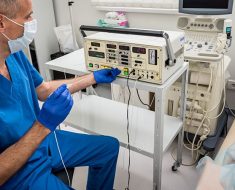
- Rates of type 2 diabetes are increasing rapidly worldwide.
- Treatment with GLP-1 agonists helps regulate blood glucose levels and decrease appetite to manage type 2 diabetes.
- However, the drugs break down rapidly in the body, so patients need regular oral tablets or injections.
- A new study has fused native GLP-1 with another protein to increase the half-life of the compound.
- This may be a first step in developing a longer-acting treatment for type 2 diabetes.
A study by scientists at the University of Tabriz, Iran, has engineered a novel long-acting GLP-1 agonist that, if successful in clinical trials, may increase the time between treatments for those with type 2 diabetes.
The study is published in
Diabetes, a chronic condition where a person’s blood glucose levels are too high, currently affects some
At least
GLP-1 agonists work by lowering blood glucose levels, slowing stomach emptying, and stimulating insulin secretion. However, they have one disadvantage — they have a short half-life, and all except one are given by subcutaneous injection, so people with type 2 diabetes (T2D) must take tablets once or twice a day or injections every day or once a week.
Current GLP-1 receptor agonists used for T2D
The
Exenatide (Byetta) is a short-acting version. This decreases after-meal blood glucose and delays gastric emptying. However, it does not have much effect on fasting blood glucose.
Longer-acting versions, which decrease fasting blood glucose levels by stimulating insulin secretion and decreasing secretion of
liraglutide (Victoza), the first once-daily GLP-1 agonist- semaglutide, which comes in two versions, a once-daily tablet (Rybelsus) and a once-weekly injection Ozempic.
dulaglutide (Trulicity), which people take once weekly.
Extending GLP-1 drug life for treating type 2 diabetes
In this study, the researchers designed chimeric proteins by fusing GLP-1 to a human serum albumin (HSA)-binding DARPin. A computational analysis found that the engineered chimeric proteins would retain their biological activity and ability to bind to the target protein.
“The study aims to develop long-acting GLP-1 receptor agonists for the treatment of type 2 diabetes by creating chimeric fusion proteins. These proteins, comprised of protease-resistant GLP-1 mutants fused to DARPin, are designed to overcome the short half-life limitation of native GLP-1.”
– Sebnem Unluisler, Genetic Engineer at the London Regenerative Institute, not involved in the study
Two of their proteins showed treatment potential. In their conclusion, the authors suggest that:
“The mGLP1-DARPin-1 fusion protein that was more resistant to
However, as this is a computational study, they emphasize that further research is needed, and their study is ongoing.
Dr. Pouya Shafipour, a board certified family and obesity medicine physician of Providence Saint John’s Health Center in Santa Monica, CA, told Medical News Today:
“Since this seems to be also increasing GLP-1 levels in the body, but maybe through a different mechanism, than the current GLP-1 receptor agonist, it might have a longer, more sustainable rise in the hormone, and be more bio available.”
GLP-1 agonists benefits and risks
The existing GLP-1 agonists are known to have
These risks may be amplified with longer-lasting treatments, as Dr. Shafipour cautioned:
“Higher levels of GLP-1 are associated with more gastrointestinal side effects, including nausea, acid reflux, constipation, and bloating, which in some individuals, could be a cause for discontinuation of the drug.”
However, she added: “If this is not a side effect due to this novel technology, this could be a great advantage over the current GLP-1 receptor agonists.”
Unluisler agreed that, given successful trials, these novel GLP-1 agonists could have the potential as long lasting treatments.
“The study utilizes a combination of molecular biology, structural prediction, and molecular dynamics simulations to assess stability, solubility and binding affinity of these fusion proteins,” she said.
“If successful in future research and clinical trials, this approach could offer a promising way to improve blood glucose control in patients with type 2 diabetes.
However, potential disadvantages include concerns about immunogenicity, cost and the method of administration. It’s crucial to await further experimental validation and clinical trials to confirm the safety and efficacy of these fusion proteins.”
– Sebnem Unluisler
So, there is certainly potential in these findings, but it may be some time before long-acting drugs are available to those with type 2 diabetes.
Source: Read Full Article





